Lazar's Education I. Pierce to Caltech
Bob Lazar’s educational background has been shrouded in mystery and confusion, with numerous myths and rumors surrounding his academic achievements. Many people seem more interested in discussing the degrees he supposedly didn’t earn and the schools he didn’t attend, rather than focusing on the schools he actually did attend. In this article, I aim to shed light on Lazar’s educational record based on the available evidence to the best of my ability.
It has been confirmed beyond a reasonable doubt that Bob Lazar worked for Fairchild Industries from 1976 until the 1980s and at Los Alamos National Labs in late 1982 as a contract technician through Kirk-Meyer. Considering these facts, Lazar had to have at least some formal education before starting to work at Los Alamos Labs.
Stanton T. Friedman’s research indicates that Lazar attended Pierce Junior College, where he took mostly Electronics classes. Friedman even spoke to one of Lazar’s teachers, Duxler, who confirmed teaching a student named Robert Lazar in the late 1970s.
To further investigate Lazar’s educational background, I made a formal request to Pierce Junior College for any information they had on Lazar. With their permission, I am able to share the following information:
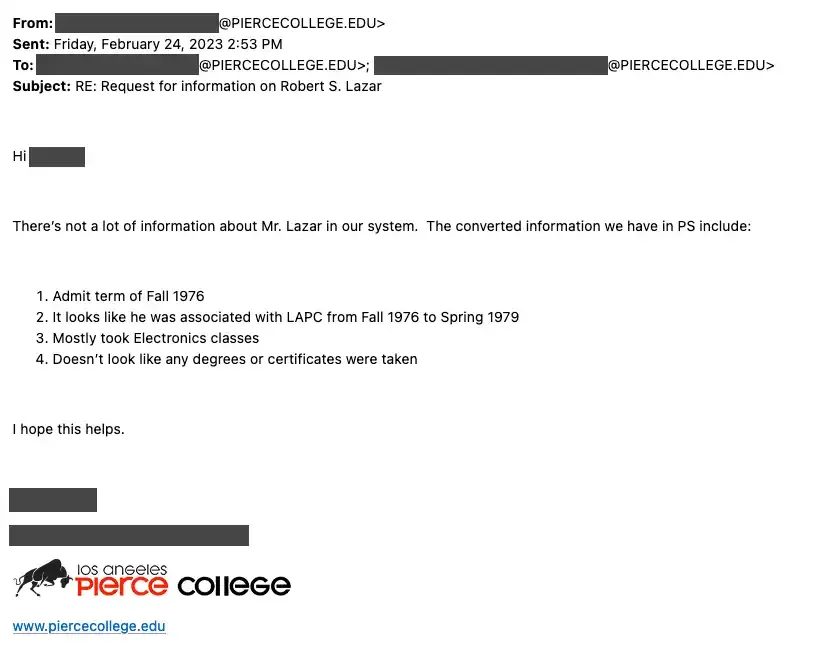
There's not a lot of information about Mr. Lazar in our system. The converted information we have in PS include:
- Admit term of Fall 1976
- It looks like he was associated with LAPC from Fall 1976 to Spring 1979
- Mostly took Electronics classes
- Doesn’t look like any degrees or certificates were taken
I hope this helps.
I would like to express my gratitude to the librarians at Pierce College Library for their invaluable assistance during my research. I have been provided with several digital copies of pages from their course catalogs of 1976 to 1979 which were indispensable for my work.
Based on these catalogs, we can make informed guesses about Lazar’s educational plans. However, without verifiable student records, an absolute determination cannot be made.
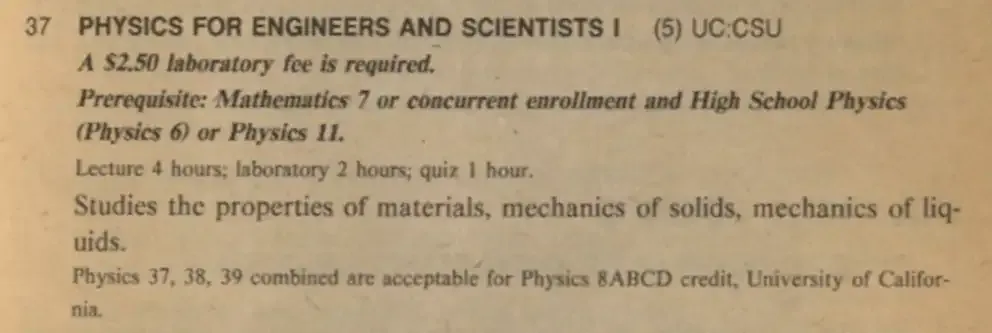
According to the catalogs, William Duxler taught the courses Physics for Engineers and Scientists 37, 38, 39 between 76 and 79. These courses were not part of an associate degree (AS) program, but rather were intended for transfer students who wished to attend Cal State Northridge or the University of California Los Angeles.
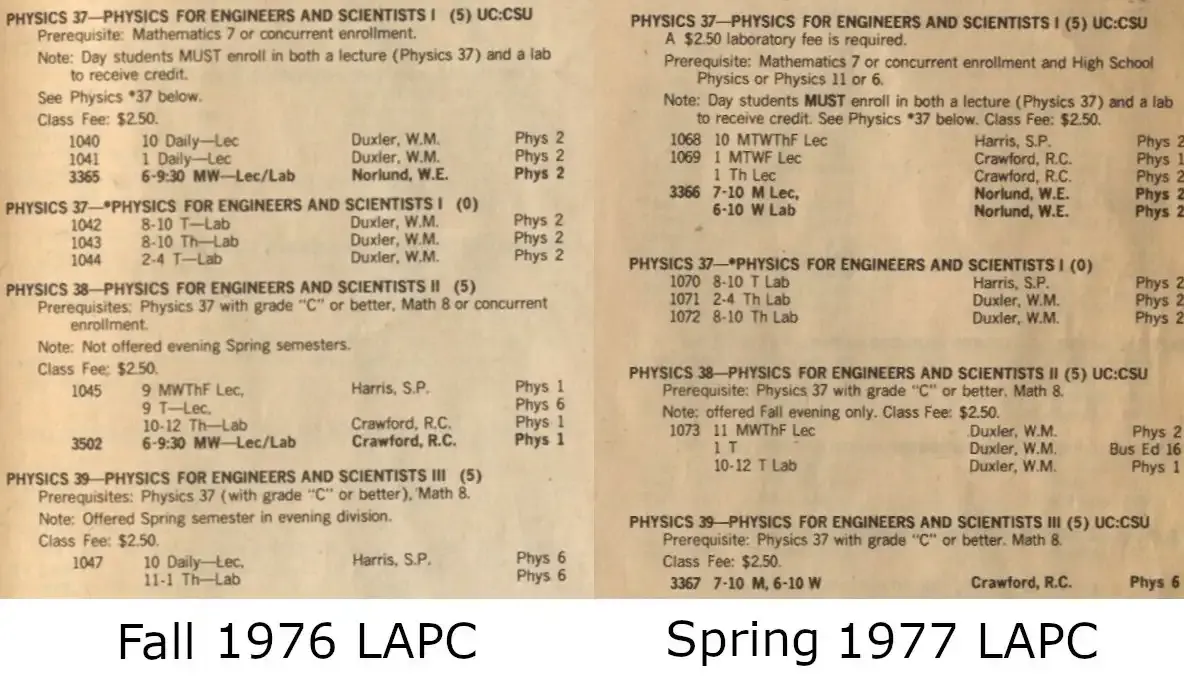
None of the stand-alone transfer programs included any electronics subjects so Lazar probably did not begin with Duxler's classes in 1976 and only took them later on. The most likely explanation is that Lazar attended Electronics classes while working towards an associate degree and later took Duxler's classes so that he could continue studying for a degree with higher standing.
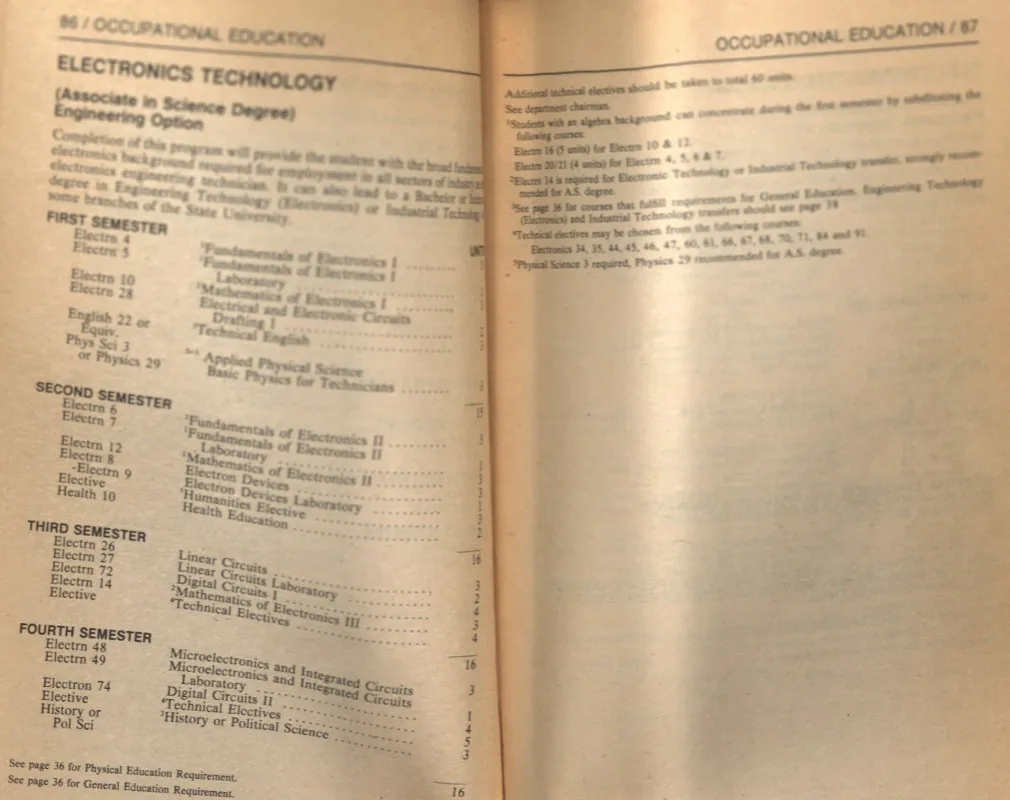
In 1976 there were three associate degrees offered by Pierce College in Electronics: Electronics Technology Engineering Option, Electronics Technology Radio and Television Option and Electronics Service Technology. Lazar most likely pursued the Engineering Option, which was described as follows:
Electronics Technology (Associate in Science Degree) Engineering Option
Completion of this program will provide the student with the broad fundamental electronics background required for employment in all sectors of industry as an electronics engineering technician. It can also lead to a Bachelor of Science degree in Engineering Technology (Electronics) or Industrial Technology at some branches of the State University.
It’s worth noting that courses from this Associate Degree could count as credits toward a Bachelor’s degree at another institution. This AS degree was sufficient to qualify someone as an electronics technician, and it is well-established that Lazar worked as a technician at Los Alamos Labs for a few months several years after leaving Pierce College.
The most likely scenario is that Lazar studied for the electronics associate degree for two years from 1976 to 1978 and then took some transfer classes, including Duxler’s, in 1978 and 1979.

In 1990, Lazar’s probation officer wrote a report in which she stated that Lazar claimed to have earned a bachelor’s degree from Pacifica University in 1978. This is impossible, as Lazar did not begin his higher education until 1976 at Pierce, and he would not have had the time to finish a 4-year degree. Nevertheless, Lazar’s friend Gene Huff later explained that:
He told her he took an English course and a history course from there. Bob needed these courses to get complete the requirements for a degree. He was simply taking the course of least resistance to achieve his goals. He had taken enough courses in science related subjects mathematics, physics, electronics, technical writing, etc., but lacked a couple of courses which are required to assemble the other courses into a degree. (Source: otherhand.org)
One may argue that the date in the police report is not reliable. However, it’s important to note that Pacifica University was a diploma mill (the "course of least resistance") that shut down in April of 1978 (US Mag Case No: 78-0271M-01 Central District of California), so Lazar could not have purchased his classes after that date. While a diploma mill is normally used to obtain a degree for the purpose of bragging or for obtaining better employment opportunities, there was nothing to prevent an individual to try to use the accompanying courses transcript as a basis for credit transfer to an accredited institute such as Pierce.
We soon discovered that diploma mills were a thriving industry from coast to coast. After looking over the crowded field, we decided to concentrate on California Pacifica University in Los Angeles… Sinclair was talking himself into serious trouble, and he must have understood that, because he was no stranger to legal difficulty. He already had served time in three states for mail fraud, and a few days after we broadcast “A Matter of Degrees” in April 1978, he was arrested and once again charged with that crime. (Source: Between you and Me)
By comparing the classes Gene Huff mentioned with Pierce's engineering courses, we can see that only the Engineering Option included all the necessary subjects, making it the most likely program Lazar pursued.
- English: Engineering Option; second semester; humanities elective
- History: Engineering Option; fourth semester; history or political science
- Mathematics: Engineering Option; first, second and third semester; Mathematics of Electronics I-III
- Physics: Engineering Option; first semester; Physics 29 recommended for A.S. degree
- Electronics: All Electronics AS degrees
- Technical Writing: Engineering Option; first semester; Technical English
Here are the courses that were needed for the other two electronics degrees:
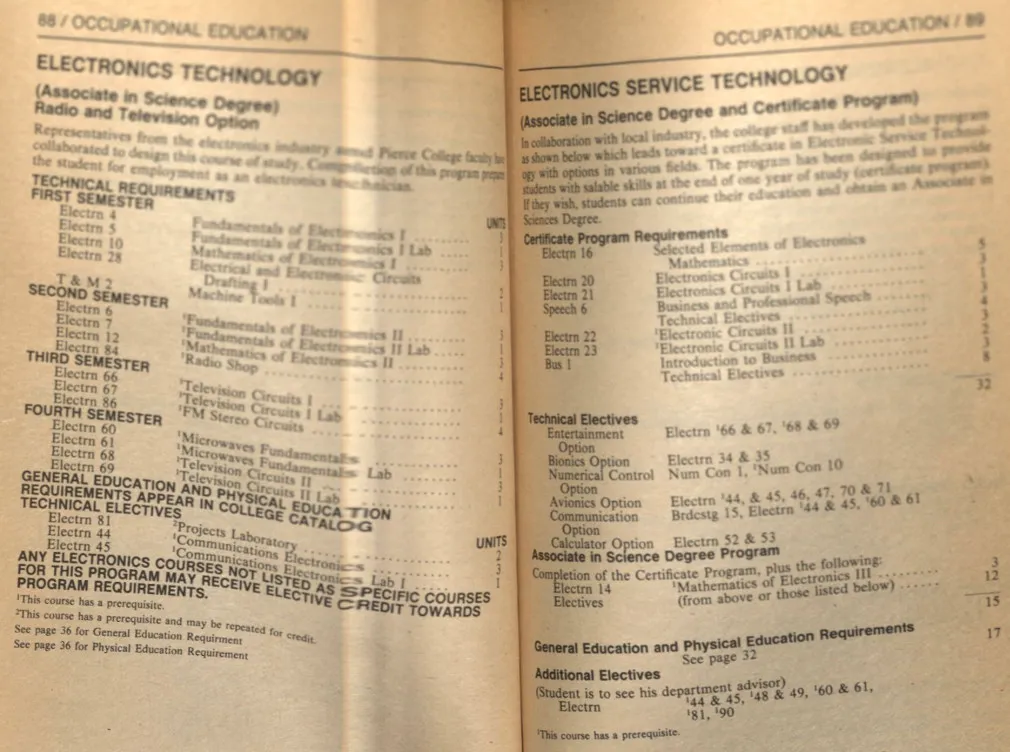
Although English and History could have been part of the General Education Requirement, many other subjects were also available to fulfill that. It should also be noted that the (other) Electronics Service Technology program required earning a certificate after one year, and according to Pierce College, no certificate was granted to Lazar.
If Lazar did complete the Electronics courses to obtain the Associate Degree, as Gene Huff suggested, why does Pierce College claim he did not earn any degrees or certificates? This is most likely due to the fact that some of Lazar's courses, namely History and English (6 credits) were obtained from a diploma mill that was later closed down by the police during a live television broadcast. As a result, Pierce College may have revoked degrees earned by individuals who took courses at Pacifica University, or perhaps they have never awarded Lazar a degree to begin with. This would explain why Lazar's education from Pierce did not appear on his marriage certificate or mentioned in any court report, as those only mention degrees that Lazar have actually obtained.
If Lazar completed his Electronics Engineering Associate Degree in two years, could he have taken Duxler's classes during his final year at Pierce in 1978–79? According to the 1978–79 Course Catalog, Duxler taught Physics for Engineers I in the fall of 1978 and was the lecturer for Physics for Engineers II and III in the spring, making this scenario possible:

Since Physics for Engineers and Scientists I was a prerequisite for both II and III, Lazar could have completed all three courses within one year.
According to Bob Lazar after Pierce he went to Northridge for a few months and after that he went to Caltech.
"After I left Pierce I went to Northridge for a short amount of time and then at the time I got a job at Fairchild Electronics which was in Canoga Park at the time, and then moved out to Simi Valley and while I was in Simi Valley that's when I started attending Cal Tech and I purposely had to rearrange my schedule at Fairchild so I can make the drive to Pasadena." (Source: Link)
There is no hard evidence that proves that Bob Lazar went to either California State University Northridge or to the California Institute of Technology, but it is also not possible to prove that he didn't go to either place.
It is possible and perhaps plausible that Lazar decided to take whatever courses he needed for his undergraduate degree, but could not get from Pierce, and have taken them at Northridge instead. Ultimately, these courses did not lead to a Bachelor’s degree, as Lazar’s name does not appear in any Northridge yearbooks. This is further corroborated by Bob Lazar's marriage certificate from July 30, 1980 which claims no degrees were taken by that time and also mentions Canoga Park to be Lazar's home town.

According to Bob Lazar himself after Northridge he went to Caltech, but assuming that he did not go there to be an undergraduate, since he is not in any Caltech yearbook, the question immediately becomes: how could he have been able to get admission to Caltech’s graduate master's program without a Bachelor's degree?
According to the 81-82 Caltech course catalog, obtaining a Bachelor's degree is technically not an absolute must to have a chance to be admitted to Caltech's one year master's degree program:
"To be admitted to graduate standing an applicant must in general have received a bachelor's degree representing the completion of an undergraduate course in science or engineering substantially equivalent to one of the options offered by the Institute. He or she must, moreover, have attained such a scholastic record and present such recommendations as to indicate that he or she is fitted to pursue, with distinction, advanced study and research. In some cases examinations may be required." (Source: Link p150)
So according to the course catalog a Bachelor's degree is a general requirement representing the completion of an undergraduate course in science or engineering. Therefore Lazar who would certainly have had the courses needed for the correct undergraduate degree, but not necessarily the degree itself could have been admitted to Caltech.
Furthermore the catalog also states that:
If the applicant's preliminary training has not been substantially that given by the four-year undergraduate options at the Institute, he or she may be admitted subject to satisfactory completion of such undergraduate subjects as may be assigned." (Source: Link p150)
Therefore it is possible that Lazar had to take undergraduate courses at Caltech in 1980-81 to earn the right to attend Caltech's graduate program while at the same time not being an undergraduate of the Institution.
Timothy Good, in the book Alien Contact, wrote that Lazar informed him that "A period of employment by Fairchild was followed by a return to Cal Tech." This could be referring to this exact scenario.
Ken Johnson a staff alumni of the AI Applications Institute of the University of Edinburgh (AIAI) claimed in a Paranet post, that:
"...I was introduced to a man that went to class with Lazar at Cal Tech. Huff invited me to Desert Blast and that's where I met him." (Source: Link)
Lazar stated several times (for a police report and at the Little A'le'Inn) that he got his first master's degree in 1982. Assuming for the sake of argument that he was referring to Caltech's one year engineering program he would have been enrolled as a graduate student for the school year of 1981-82 at the institute.
Michael Hesemann, in the book Beyond Roswell, mentions that Lazar's friend Jim Tagliani:
“worked with Lazar at Fairchild Industries in Los Angeles in 1981” and stated that he “had no doubts at all about Lazar having studied at Caltech.” (Source: Link)
This corresponds with Lazar's previous statement of "I got a job at Fairchild Electronics which was in Canoga Park at the time, ... I was in Simi Valley that's when I started attending Cal Tech and I purposely had to rearrange my schedule at Fairchild so I can make the drive to Pasadena" According to Lazar's friend who also worked at Farichild: "the company originally was Xincom and then it got bought up by Fairchild." (Source: Link) One interesting question is when did Xincom Fairchild move from Canoga Park to Simi Valley, as that would indicate the time Lazar, according to himself, began attending Caltech in earnest. The last mention I could find of Xincom which was located at Canoga park and was bought by Farchild is from January 1981:
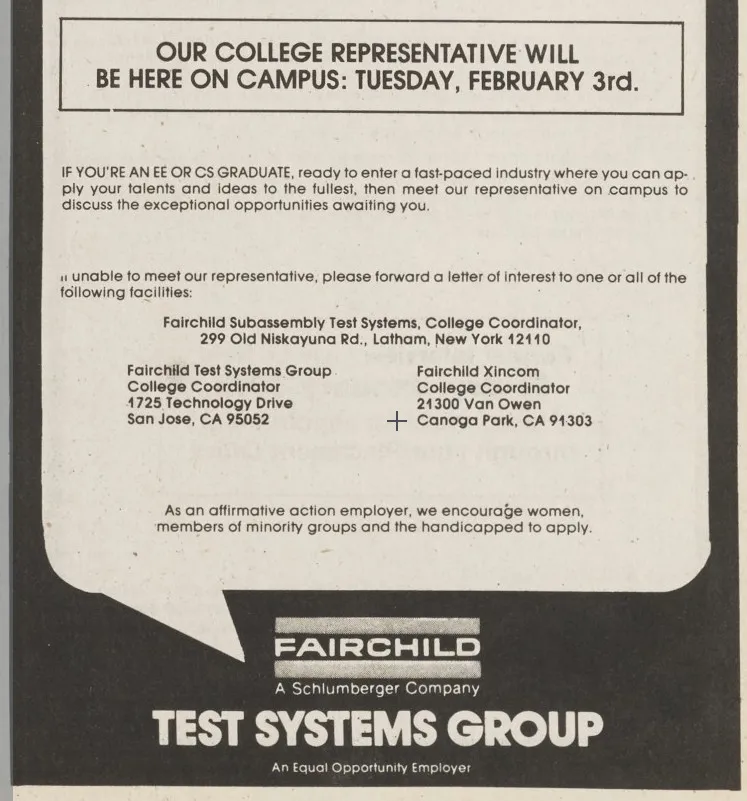
A former employee of Farchild Peter G. also stated that:
So it’s a little bit, it’s a little bit hazy, but ‘81, ‘82ish. Fairchild used to be in Canoga Park. I left the company before they moved to Simi Valley, about six months before they moved to Simi Valley. I only worked for Fairchild a little bit over a year. (Source: Link)
Based on this information we can confirm, that Lazar moved to Simi Valley and began attending Caltech some time after January 1981 further corroborating Tagliani's statements, or, at the very least, we can state that if Lazar ever did attend graduate courses at Caltech it would have been then. Lazar could have finished his master’s in 1982, the same year he started working at Los Alamos National Laboratory.
In his biography Bob Lazar mentions that:
I originally worked at Fairchild as a technician repairing broken circuit boards, but eventually became a test engineer and later an engineer designing circuit and logic boards. I loved electronics and I was earning money and going to school at Caltech by this time. I was studying electronics there mainly because the people at Fairchild thought that was the best use of my time.
...
And there I was at the age of twenty-three, working as an electronics engineer even though I was stil a few credits shy of actually having a college degree. I wanted more, so in the summer of 1982, I sent a cover letter and resume to Los Alamos National Laboratory. (Source: Link)
And so Bob Lazar might have gotten his degree at the end of 1982 instead of early summer, but either way, there's a very good chance that he indeed received a master's degree from Caltech.
Lazar's education career in California could be summarized as follows:
- 1976 - 1978 Pierce Junior College; Electronics Technology, Engineering Option (Associate in Science Degree)
- 1978 - 1979 Pierce Junior College; Transfer classes for higher education;
- 1979 - 1980 California State University Northridge; Undergraduate classes;
- 1980 - 1981 California Institute of Technology; Replacement undergraduate classes;
- 1981 - 1982 California Institute of Technology; Electrical Engineering Graduate Program (Master of Science Degree)
Part two can be found here: Lazar's Education II !